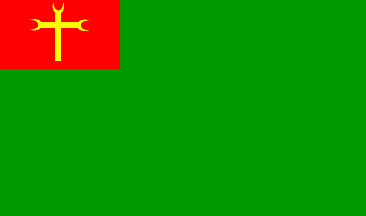
Last modified: 2016-04-30 by alex garofolo
Keywords: trinidad | cross: yellow on red | cross: horned | canton: cross | moxo | mojo | ignaciano | trinitario |
Links: FOTW homepage |
search |
disclaimer and copyright |
write us |
mirrors

The flag and a coat of arms of Trinidad were officialy presented by the
Municipal Council on 5 October 2006. The flag is dark green with a red canton
charged with a yellow cross whose arms end with horns. Green represents the
pampas (grasslands) and bajíos (flooded lowlands) of the
region and recall the national flag [note that the flag
of the department of Beni is plain dark green]. Red
represents the blood shed by the men and women of the Mojeño indigenous
groups [c. 75,000 sedentary farmers-hunters, aka Moxo, Moxos, Mojos, Mojo,
Moxeno, Ignaciano or Trinitario]. The yellow cross represents the Beni
indigenous groups, whereas the horns are a symbol of the power, the strength
and the victory of Jesus dead on the cross. The
official dimensions of the flag are 1.30 × 2.20 m. The 5th of October shall
be the Day of the Flag and Coat of Arms of Trinidad.
Ivan Sache, 15 Oct 2006, from
Red
Bolivia
A newswire
by the ABI agency, 10 October 2006, adds that the symbols of Trinidad
shall be used during the civic and religious festivals by the public and
private institutions as well as by the education and miltary establishments.
The cross is said there to represent the spirituality of the town.
Ivan Sache, 15 Oct 2006
The APG
agency reports on 7 May 2006 that the changes decided by the Municipal
Council in the coat of arms and flags of the municipality of Trinidad (the
capital city of the province of Beni) have been
criticized by the priest, Adán Bravo. The priest claims that everybody
must reject the new symbols because nobody was consulted before their
adoption. I don’t really understand the details of the quarrel, but this
proves that the municipality of Trinidad has a flag and a coat of arms, and
that those symbols were recently changed.
Ivan Sache, 10 May 2006
The town of Trinidad (officially, La Santísima Trinidad; c. 82,000
inhabitants) is the capital city of the department of
Beni. The town was founded in 1686 by the Jesuit Father Cipriano Barace
about 14 kilometers of its present location. The original city was on the
Mamoré river, but flooding and disease forced a move to higher ground
in 1769. The main tourist spots near Trinidad are the Suárez laguna and the
Mamoré river, the longest tributary of Amazon, famous for its parrot
and macaw flocks, pink river dolphins, piranhas, vultures, monkeys and
caymans.
Ivan Sache, 15 Oct 2006, from
Tunari
Anything below this line was not added by the editor of this page.